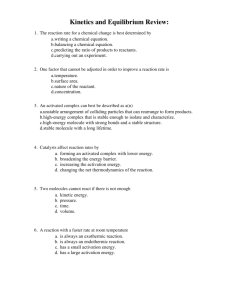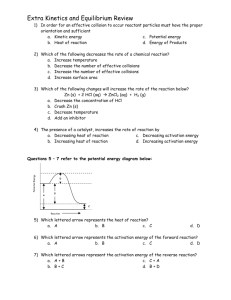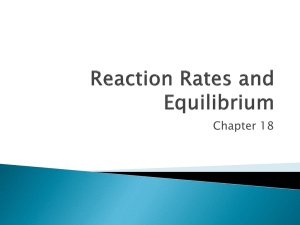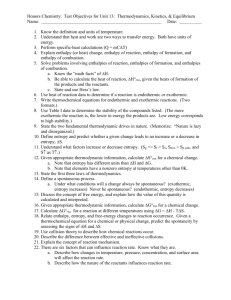KINETICS AND EQUILIBRIUM REVIEW PACKET – RC 1) In which
advertisement
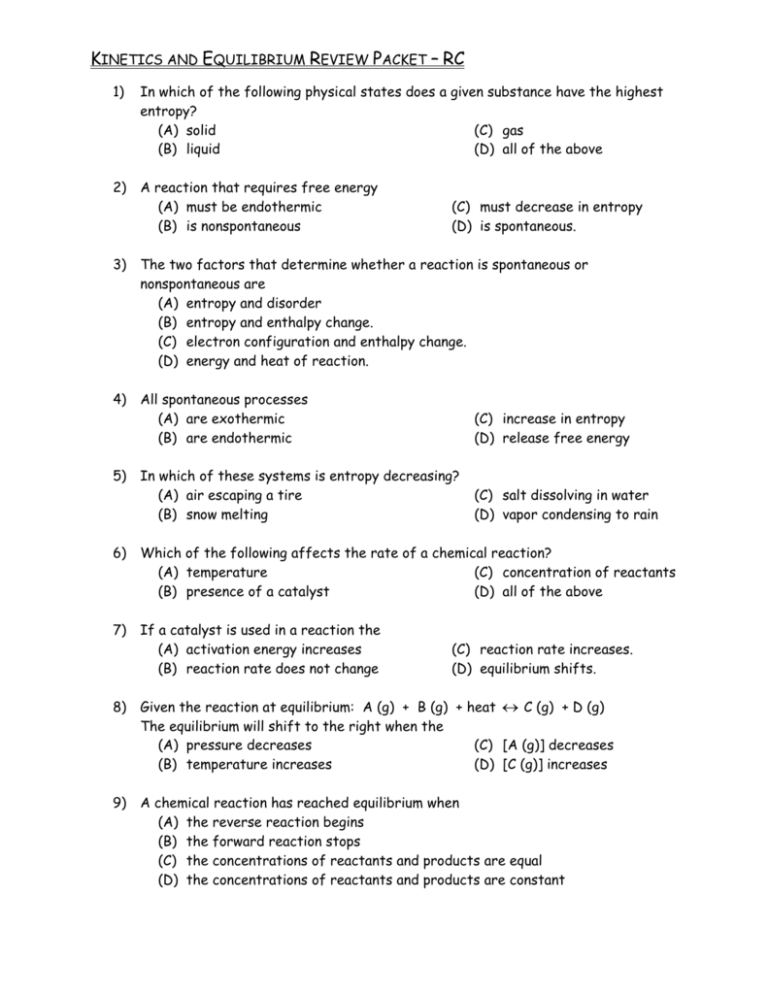
KINETICS AND EQUILIBRIUM REVIEW PACKET – RC 1) In which of the following physical states does a given substance have the highest entropy? (A) solid (C) gas (B) liquid (D) all of the above 2) A reaction that requires free energy (A) must be endothermic (B) is nonspontaneous (C) must decrease in entropy (D) is spontaneous. 3) The two factors that determine whether a reaction is spontaneous or nonspontaneous are (A) entropy and disorder (B) entropy and enthalpy change. (C) electron configuration and enthalpy change. (D) energy and heat of reaction. 4) All spontaneous processes (A) are exothermic (B) are endothermic (C) increase in entropy (D) release free energy In which of these systems is entropy decreasing? (A) air escaping a tire (B) snow melting (C) salt dissolving in water (D) vapor condensing to rain 5) 6) Which of the following affects the rate of a chemical reaction? (A) temperature (C) concentration of reactants (B) presence of a catalyst (D) all of the above 7) If a catalyst is used in a reaction the (A) activation energy increases (B) reaction rate does not change (C) reaction rate increases. (D) equilibrium shifts. 8) Given the reaction at equilibrium: A (g) + B (g) + heat ↔ C (g) + D (g) The equilibrium will shift to the right when the (A) pressure decreases (C) [A (g)] decreases (B) temperature increases (D) [C (g)] increases 9) A chemical reaction has reached equilibrium when (A) the reverse reaction begins (B) the forward reaction stops (C) the concentrations of reactants and products are equal (D) the concentrations of reactants and products are constant 10) If a catalyst is added to a system at equilibrium and the temperature and pressure remain constant, there will be no effect on the (A) rate of the forward reaction (C) activation energy (B) rate of the reverse reaction (D) heat of reaction 11) Which (A) (B) (C) (D) factors must be equal in a reversible chemical reaction at equilibrium? concentrations of reactants and products potential energy of reactants and products activation energy of the forward and reverse reactions rates of the forward and reverse reactions 12) A sample of water in a sealed flask at 298 K is in equilibrium with its vapor. This is an example of (A) chemical equilibrium (C) solution equilibrium (B) phase equilibrium (D) static equilibrium 13) Given the reaction at equilibrium: NaCl (s) ↔ Na+ (aq) + Cl- (aq) The addition of KCl to this system will cause a shift in the equilibrium to the (A) left and the concentration of the Na+ (aq) ions will increase (B) right and the concentration of the Na+ (aq) ions will increase (C) left and the concentration of the Na+ (aq) ions will decrease (D) right and the concentration of the Na+ (aq) ions will increase 14) Two reactant particles collide with proper orientation. The collision will be effective if the particles have (A) sufficient potential energy (C) high ionization energy (B) high activation energy (D) sufficient kinetic energy 15) The reaction A + B Æ C + D + 30 kJ has a forward activation energy of 20 kJ. What is the activation energy of the reverse reaction? (A) 50 kJ (B) 20 kJ (C) 30 kJ (D) 10 kJ 16) Determine the direction of the equilibrium shift using LeChatilier’s principle when each of the following stresses is applied to the chemical equilibrium below. 4 NH3 (g) + 5 O2 (g) ↔ 4 NO (g) + 6 H2O (g) + heat (A) Increase [NO] _____________ (B) Decrease heat _____________ (C) Increase pressure _____________ (D) Decrease [O2] _____________ 17) Nitrogen gas reacts with hydrogen gas to form ammonia gas according to the following potential energy diagram. (A) Is the reaction endothermic or exothermic? Justify. (B) If the activation energy of the forward reaction is 5.0 kJ, what is the activation energy of the reverse reaction? (C) Write the chemical equation for the reaction on the line below. Put the energy on the correct side of the arrow as a reactant or product. 18) Entropy is a measure of __________ in a system. All systems in nature tend to favor an ___________ in entropy. (∆S = ______) 19) For a reaction to occur spontaneously at any temperature there must be a(n) ___________ in enthalpy and a(n) ____________ in entropy. (∆H = _______ and ∆S = ______) 20) Identify the meaning of each of the following Gibbs Free Energy (∆G) values: (A) ∆G = ______________________ (B) ∆G = + ______________________ (C) ∆G = 0 ______________________ Questions 21 through 25 refer to the following potential energy diagram. 21) Using the potential energy diagram above, identify the region on the curve indicated by each letter. A)________________________________ B)________________________________ C)________________________________ D)________________________________ 22) Does the curve represent an endothermic or exothermic reaction? Justify your answer. 23) On the diagram, label the region which represents the activation energy of the reverse reaction with the letter E. 24) Explain how the addition of a catalyst will influence the heat of reaction. 25) Explain how the addition of a catalyst will influence the activation energy of the forward reaction.

